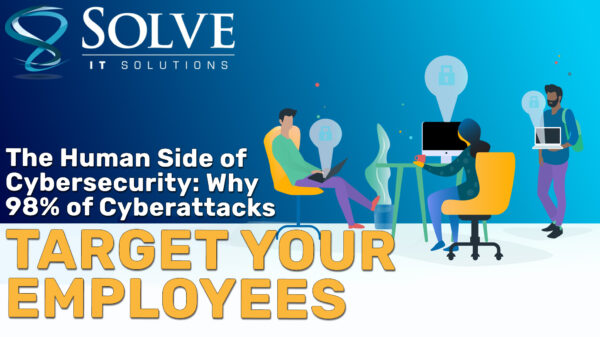The Human Side of Cybersecurity: Why 98% of Cyberattacks Target Your Employees (Not Your Technology)


Your firewall is bulletproof. Your antivirus is cutting-edge. Your passwords are complex. So why are hackers still getting in?
Because they’re not attacking your technology—they’re attacking your people.
Here’s a statistic that should keep every business owner awake at night: 98% of cyberattacks involve some form of social engineering. That means hackers aren’t spending their time trying to crack your sophisticated security systems. Instead, they’re crafting convincing emails, phone calls, and messages designed to trick your employees into handing over the keys to your digital kingdom.
The Shocking Reality of Social Engineering Attacks
Social engineering isn’t just a buzzword—it’s the primary weapon in every cybercriminal’s arsenal. These attacks manipulate human psychology, exploiting trust, fear, and urgency to bypass even the most advanced security measures.
The numbers are staggering: 90% of cyberattacks target an organization’s employees directly. The average business faces over 700 social engineering attacks each year, with the average cost of a successful attack reaching $130,000 in 2024. For small businesses, this can be devastating—especially since 85% of organizations experienced at least one social engineering attack last year.
What makes this even more concerning? 68% of data breaches in 2024 were attributed to human error, including social engineering scams. When technology fails, it’s often because a human element was compromised first.
The Many Faces of Social Engineering
Social engineering attacks come in various forms, each designed to exploit different aspects of human nature:
Phishing remains the king of social engineering, accounting for 70% of all attacks in this category. These fraudulent emails appear to come from trusted sources—banks, suppliers, even your own CEO—asking employees to click links, download attachments, or share sensitive information. What’s particularly alarming is that phishing attempts rose by 58.2% in 2023, with 43% of attacks impersonating Microsoft.
Spear phishing takes this further by targeting specific individuals with personalized messages. Instead of casting a wide net, attackers research their targets and craft highly convincing communications that appear to come from colleagues, business partners, or trusted contacts.
Vishing (voice phishing) and smishing (SMS phishing) are growing rapidly. With over 4 million mobile-focused social engineering attacks recorded in 2024, these tactics exploit our trust in phone calls and text messages. Mobile devices see much higher open rates than email—between 8-14% compared to email’s 2%—making them attractive targets for cybercriminals.
Business Email Compromise (BEC) attacks target employees outside of finance and executive roles 77% of the time, often focusing on sales employees who frequently communicate with external contacts. These sophisticated attacks can cost organizations an average of $4.89 million per incident.
The Small Business Vulnerability Gap
Small and medium-sized businesses face unique challenges when it comes to social engineering attacks. While large enterprises have dedicated cybersecurity teams and extensive training programs, smaller organizations often operate with limited resources and less formal security protocols.
The statistics reveal a critical gap: 45% of employees report receiving no security training whatsoever from their employers. Only 52% of organizations conduct anti-phishing training, and just 25% provide training specifically focused on social engineering tactics. This leaves millions of workers—and their employers—vulnerable to attacks that could be prevented with proper awareness and preparation.
The Cost of Being Unprepared
The financial impact of social engineering attacks extends far beyond the initial breach. Consider these sobering facts:
- 83% of organizations experienced more than one insider attack in 2024
- The median ransom payment jumped from under $200,000 in early 2023 to $1.5 million by mid-2024
- Ransomware breaches take an average of 326 days to contain—49 days longer than other types of data breaches
- Small organizations remain the most vulnerable, with 55.8% of ransomware attacks targeting companies with 1-50 employees
These aren’t just statistics—they represent real businesses that faced devastating financial losses, operational disruptions, and reputational damage because their employees were targeted by sophisticated psychological manipulation.
Building Your Human Firewall
The good news? Organizations that invest in comprehensive cybersecurity awareness training see a 70% reduction in security-related risks. Employees who undergo proper training are 30% less likely to click on phishing links, and security awareness training can provide a return on investment of over $177,000 in prevented losses.
Essential protective measures include:
Regular Training Programs: Move beyond annual cybersecurity presentations to ongoing, engaging training that covers current threats. Only 30% of organizations offer ransomware-focused training, despite ransomware being the top cybersecurity concern for over half of all companies.
Phishing Simulations: 92% of organizations invest in phishing simulations because they work. Regular testing helps identify vulnerable employees and reinforces proper security behaviors.
Multi-Factor Authentication (MFA): This simple measure reduces social engineering risks by 70% by adding an extra verification step that attackers can’t easily bypass.
Verification Protocols: Establish clear procedures for confirming requests for sensitive information or financial transactions, especially those marked as “urgent” or coming from executive leadership.
Security Culture Development: Create an environment where employees feel comfortable reporting suspicious activities and asking questions about potential threats.
Technology and Training Working Together
While human-focused training is crucial, combining it with technology creates the strongest defense. Organizations that extensively use security AI and automation realize average cost savings of $2.22 million compared to those that don’t. AI-based monitoring tools can detect social engineering attempts with 80% accuracy, while providing real-time alerts about suspicious patterns.
However, technology alone isn’t enough. Despite 90% of companies having security awareness training programs, 70% of their employees still behave insecurely. This highlights the need for more sophisticated, behavior-based training approaches that create lasting change rather than temporary awareness.
Your Next Steps
Social engineering attacks are becoming more sophisticated and more frequent. AI-driven social engineering attacks grew by 50% recently, with machine learning helping attackers craft highly personalized and convincing schemes. The attackers are evolving—and your defenses need to evolve too.
The human element will remain a factor in 80% of breaches, making employee education and awareness your most critical security investment. Every employee is both your greatest vulnerability and your strongest defense against social engineering attacks.
Ready to strengthen your human firewall? The conversation starts with assessing your current security awareness posture and developing a comprehensive training program tailored to your specific risks and industry challenges. In the battle against social engineering, informed employees are your best defense.
